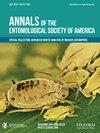Insect Gap Junctions Could Be a Potential Target for Pest Management
IF 1.8
3区 农林科学
Q1 ENTOMOLOGY
引用次数: 1
Abstract
Abstract Gap junctions are integral membrane proteins that play a role in cell-to-cell communication. They are coded by the functional genes called connexins in chordates and innexins in invertebrates. However, recently pannexins were also found in mammalian genomes, which are homologous to insect innexins. Gap junction intercellular communication (GJIC) has different functions ranging from their role in ontogenesis to the transfer of intracellular signal molecules and minimizing the adverse effects of xenobiotics by dilution and steady-state catabolism. Perturbations of these gap junctions are known to promote cancers besides, and many tumor inducers reduce the functioning of these gap junctions. Insect gap junctions play a crucial role in the development of insects and perhaps might be one of the reasons for the success of insects on terrestrial habitats. Majority of the work on innexins was done on Drosophila melanogaster Meigen, 1830 (Diptera: Drosophilidae), and its innexins regulate size of the central nervous system, embryonic gut formation, metamorphosis, and the fertility of germ lines in the reproductive system. There are several insecticides like cyclodienes, organochlorines, phenypyrazoles, synthetic pyrethroids, avermectins, milbemycins, oxadiazines, semicarbazones, metadiamides, isoxazolines which target ion channels in the insects, but there is no evidence that supports the possible toxic effects of insecticides on insect gap junctions. In this review, we discuss the importance of insect gap junctions and how they could be a potential target for chemical pest management.昆虫间隙连接可能成为害虫管理的潜在目标
摘要间隙连接是在细胞间通讯中发挥作用的膜蛋白。它们由脊索动物中称为连接蛋白的功能基因和无脊椎动物中称为内连接蛋白的基因编码。然而,最近在哺乳动物基因组中也发现了潘奈辛,它们与昆虫潘奈辛同源。间隙连接细胞间通讯(GJIC)具有不同的功能,从其在个体发生中的作用到细胞内信号分子的转移,以及通过稀释和稳态分解代谢将外源性物质的不良影响降至最低。此外,已知这些间隙连接的扰动会促进癌症,许多肿瘤诱导剂会降低这些间隙连接功能。昆虫间隙连接在昆虫的发育中起着至关重要的作用,也许也是昆虫在陆地栖息地成功的原因之一。关于innexins的大部分工作是在果蝇(Drosophila melanogaster Meigen,1830)上完成的(Diptera:Drosophilidae),其innexins调节中枢神经系统的大小、胚胎肠道的形成、变态和生殖系统中生殖系的育性。有几种杀虫剂,如环二烯类、有机氯类、苯吡唑类、合成拟除虫菊酯类、阿维菌素、密霉素、恶二嗪类、氨基脲类、偏二酰胺类、异恶唑啉类,它们靶向昆虫的离子通道,但没有证据支持杀虫剂对昆虫缝隙连接可能产生的毒性作用。在这篇综述中,我们讨论了昆虫缝隙连接的重要性,以及它们如何成为化学害虫管理的潜在目标。
本文章由计算机程序翻译,如有差异,请以英文原文为准。
求助全文
约1分钟内获得全文
求助全文
来源期刊
CiteScore
4.90
自引率
0.00%
发文量
25
审稿时长
6-12 weeks
期刊介绍:
The Annals of the Entomological Society of America exists to stimulate interdisciplinary dialogue across the entomological disciplines and to advance cooperative interaction among diverse groups of entomologists. It seeks to attract and publish cutting-edge research, reviews, collections of articles on a common topic of broad interest, and discussion of topics with national or international importance. We especially welcome articles covering developing areas of research, controversial issues or debate, and topics of importance to society. Manuscripts that are primarily reports of new species, methodology, pest management, or the biology of single species generally will be referred to other journals of the ESA. The most important criteria for acceptance are quality of work and breadth of interest to the readership.

 求助内容:
求助内容: 应助结果提醒方式:
应助结果提醒方式:


